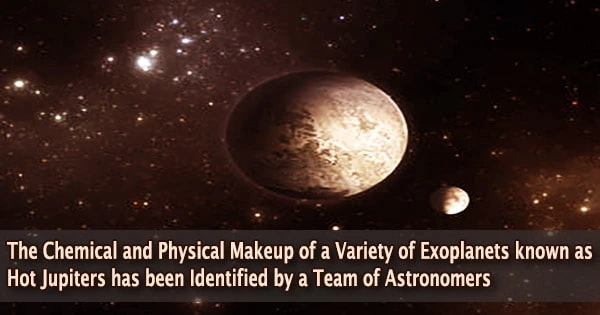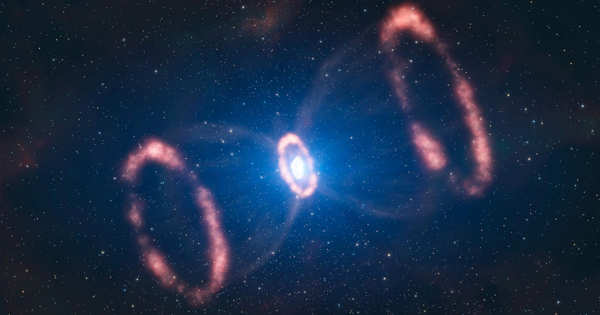Thanks to a recent study combining theoretical modeling with Hubble Space Telescope data, hot Jupiters, gigantic gas planets that speed around their host stars in incredibly tight orbits, have become a little less mysterious.
Previous research has largely focused on individual worlds labeled as “hot Jupiters” because of their superficial resemblance to our own solar system’s gas giant, the new study is the first to look at a larger population of the unusual worlds.
The work, led by a University of Arizona researcher, is published in Nature Astronomy and provides astronomers with an unprecedented “field guide” to hot Jupiters as well as information into planet formation in general.
Although astronomers estimate that only about one in every ten stars hosts a hot Jupiter-class exoplanet, the strange planets account for a significant portion of exoplanets discovered to date, owing to their larger size and brightness compared to other types of exoplanets, such as rocky, Earth-like planets or smaller, cooler gas planets.
All hot Jupiters orbit their host star at an extraordinarily close range, usually much closer than Mercury, our solar system’s innermost planet is to the sun. They range in size from around one-third the size of Jupiter to ten Jupiter masses.
On a typical hot Jupiter, a “year” lasts only a few hours or days. Mercury, by comparison, takes over three months to complete one orbit around the sun.
Most, if not all, hot Jupiters are assumed to be trapped in a high-speed embrace with their host stars, with one side perpetually exposed to the star’s radiation and the other cloaked in continuous darkness, owing to their close orbits.
A typical hot Jupiter’s surface may reach temperatures of about 5,000 degrees Fahrenheit, with “cooler” specimens attaining temperatures of 1,400 degrees, hot enough to melt aluminum.
Megan Mansfield, a NASA Sagan Fellow at the University of Arizona’s Steward Observatory, led the study, which relied on Hubble Space Telescope images that allowed the team to directly quantify emission spectra from hot Jupiters despite Hubble’s inability to picture any of these planets.
“These systems, these stars, and their hot Jupiters are too far away to resolve the individual star and its planet,” Mansfield said. “All we can see is a point the combined light source of the two.”
We basically measure the combined light coming from the star and its planet and compare that measurement with what we see when the planet is hidden behind its star. This allows us to subtract the star’s contribution and isolate the light emitted by the planet, even though we can’t see it directly.
Megan Mansfield
Mansfield and her colleagues utilized a technique called secondary eclipsing to extract data from the observations, allowing them to peek deep into the planets’ atmospheres and learn more about their structure and chemical makeup.
The method entails making multiple observations of the same system, catching the planet at various points in its orbit, including when it passes in front of the star.
“We basically measure the combined light coming from the star and its planet and compare that measurement with what we see when the planet is hidden behind its star,” Mansfield said. “This allows us to subtract the star’s contribution and isolate the light emitted by the planet, even though we can’t see it directly.”
The eclipse data gave the researchers insight into the thermal structure of hot Jupiters’ atmospheres, allowing them to create individual temperature and pressure profiles for each one.
The team then looked for so-called absorption signatures in near-infrared light emanating from each hot Jupiter system, which is a region of wavelengths just beyond what humans can see.
Researchers can learn about the chemical makeup of hot Jupiters by studying at different wavelengths because each molecule or atom has its own unique absorption signature, similar to a fingerprint. If there is water in the planet’s atmosphere, for example, it will absorb light at 1.4 microns, which is within the range of wavelengths that Hubble can see.
“In a way, we use molecules to scan through the atmospheres on these hot Jupiters,” Mansfield said. “We can use the spectrum we observe to get information on what the atmosphere is made of, and we can also get information on what the structure of the atmosphere looks like.”
The researchers took it a step further by quantifying the data and comparing it to models of the physical processes that are thought to be at action in the atmospheres of hot Jupiters.
According to Mansfield, the discoveries are “interesting because they were anything but assured,” demonstrating that many assumptions regarding the nature of the planets based on theoretical studies appear to be valid.
The findings suggest that all hot Jupiters, not only the 19 studied, are expected to have comparable chemical compositions, such as water and carbon monoxide, as well as lower amounts of other molecules.
Individual planet differences should mostly consist of varying relative amounts of these chemicals. The studies also revealed that the water absorption properties seen on each hot Jupiter differed differently.
“Taken together, our results tell us there is a good chance we have the big picture items figured out that are happening in the chemistry of these planets,” Mansfield said. “At the same time, each planet has its own chemical makeup, and that also influences what we see in our observations.”
The findings, according to the scientists, can be used to inform astronomers’ expectations of what they could see when looking at a hot Jupiter that hasn’t been investigated before. Exoplanet hunters eagerly anticipating the launch of NASA’s new flagship telescope, the James Webb Space Telescope, on Dec. 18, since Webb will be able to see in a much wider range of infrared light, allowing for a much more detailed study at exoplanets, including hot Jupiters.
“There is a lot that we still don’t know about how planets form in general, and one of the ways we try to understand how that could happen is by looking at the atmospheres of these hot Jupiters and figuring out how they got to be where they are,” Mansfield said.
“With the Hubble data, we can look at trends by studying the water absorption, but when we are talking about the composition of the atmosphere as a whole, there are many other important molecules you want to look at, such as carbon monoxide and carbon dioxide, and JWST will give us a chance to actually observe those as well.”
















